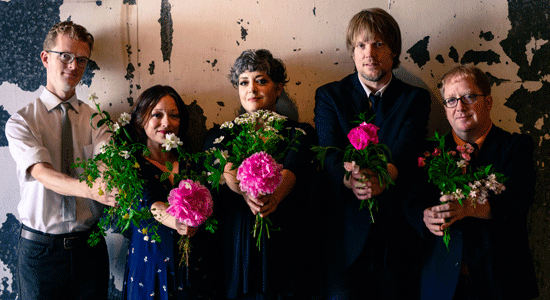
Chicago supergroup the Flat Five are guided by voices
In music, a flat five is a passing chord that harmonizes well with almost any sound. The singers in Chicago’s Flat Five—Kelly Hogan, Nora O’Connor, Scott Ligon, Casey McDonough and Alex Hall—are as versatile as the name of their group implies. They’re all well-known songwriters, musicians and side-persons in their own right, but when they sing as the Flat Five, they touch on something transcendent. Their complex, intertwining harmonies bring to mind the shimmering sounds of the Four Freshmen, Beach Boys, Lambert, Hendricks And Ross, Harry Nilsson and the Everly Brothers—singers who could create breathtaking emotional effects using nothing but their voices.
“We’re in this band because we’re harmony junkies,” says Hogan, who cofounded the group with Ligon. “We’re all in a million other bands, but every time we get a chance, we get together to sing, and we work hard at it. We love singing harmonies. Our rehearsals can go on for seven hours or more, even if we’re not preparing for a show.”
Hogan and Ligon first got together for a one-off show as a duo. “We talked for 10 minutes and started referencing songs by the Davis Sisters, Wilburn Brothers, Georgie Fame and Lou Rawls,” says Hogan. “The first time we sang together, there was an obvious click. I was in a secular gospel group with Nora called the Lamentations, so I asked her to join us. We sounded so good, we began looking for other people, and it became a snowball that gathered up this group of harmony dorks who all happen to play about a billion instruments as well.”
The Flat Five started as a cover band, doing tunes by Lambert, Hendricks And Ross, Nilsson, Oscar Brown Jr. and Leslie Gore. Gradually, the group began adding songs by Scott Ligon’s brother Chris, a writer with a skewed vision and unusual sense of melody and rhythm. “We do a lot of his songs in our live set,” says Hogan, “but he’s not a well-known writer. When we decided to make an album, we thought we’d avoid the curse of the cover band by doing songs most people hadn’t heard before.”
The result, It’s A World Of Love And Hope, is an album full of delirious vocal harmonies, anchored by Chris Ligon’s peculiar worldview. “The songs are weird and twisted, dark and light at the same time, with a wry sense of humor,” says Hogan. “We recorded live, sometimes with the five of us gathered around a single microphone. We decided we wanted an uplifting title for the record, so we went with It’s A World Of Love And Hope. It’s a lyric from ‘This Is Your Night.’ My last solo album was called I Like To Keep Myself In Pain, so I made a conscious decision to stay positive in this band, to be shamelessly hopeful in the face of climate change and Donald Trump. Some people don’t believe life can be wonderful, but if you look at all the little things around you, you’ll see it is.”
—j. poet





